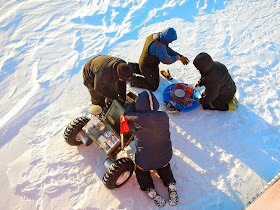In order to economically transport fuel and other cargo overland to remote research stations in Antarctica and Greenland, hundreds of miles of glacial ice must be safely navigated. Within the ice exist treacherous and often invisible crevasses that pose a serious hazard to those of us hauling the supplies.
CRREL engineers prepare Yeti for a GPR survey in Greenland
In an effort to minimize this risk students and faculty from Dartmouth College working with researchers from the U.S. Army Cold Regions Research & Engineering Laboratory (CRREL)
designed and fabricated Yeti. This autonomous robot utilizes Ground Penetrating Radar (GPR) to survey ice sheets in Antarctica and Greenland for hidden crevasses.
In realtime, the above map shows Yeti's progress as the Strategic Crevasse Avoidance Team (SCAT) establishes a 70-mile route from Thule Air Base onto the Greenland Ice Sheet so the Greenland Inland Traverse (GrIT) can safely resupply Summit Station.
The National Science Foundation’s Office of Polar Programs and NASA’s Jet Propulsion Laboratory funded Yeti's development.


No comments:
Post a Comment